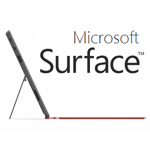
In June 18th, 2012, at Milk Studios in Los Angeles, Microsoft unveiled its first ever tablet, the Microsoft Surface Tablet. The Surface that is debuted in two models, marketed as Surface RT and Surface Pro, is the company's strategy in stepping into the tablet market at a critical juncture when growth in PC sales is slowing and consumer interest in iPads is soaring.
Speaking at an event, Steve Ballmer said the two touchscreen devices made "no compromises" between tablet and PC capabilities.
With the Surface RT that is powered by Windows RT and Nvidia Tegra 3 (ARMv7) processor, and Surface Pro with Intel Ivy Bridge Core-i5 CPU and Windows 8, Microsoft challenges Apple's bestselling iPad and tablets built on Google's Android mobile operating system, such as the Amazon Kindle Fire, that are selling strongly.
Microsoft is hoping that its new hardware will allow users to replace their Apple iPads and Windows 7 laptops with new Windows 8 tablets.
"We believe that any intersection between human and machine can be made better when all aspects of the experience - hardware and software - are considered and working together," said Steve Ballmer. "Today we want to add another bit of excitement."
A Tablet Experience with Laptop Capability
The Surface tablets are built with a molded magnesium casing known as "VaporMg" (pronounced "VaporMag"). The hard shell houses all of the Surface's internal components paired with a PVD finish and a built-in kickstand that allows the device to be propped up for viewing.
Both RT and Pro include several hardware buttons and inputs, including a power button and volume buttons - not much of a difference from Apple's iPad. But beside a single button like the iPad, the bottom of the Surface's front-side casing centered a touch sensitive Windows key.
The bottom of both Surface devices includes a magnetic data connector through which the keyboard covers connect to and communicate with the device. For ports, Surface RT features a full-size USB 2.0 port, an HD video out port, and a microSDXC card slot; Surface Pro includes a full-size USB 3.0 port, Mini DisplayPort port, and microSDXC card slot. Both models have two 720p HD front and rear cameras.
With 10.6 inches (27 cm) and a 16:9 aspect ratio, Surface RT has 1366 by 768 display while Surface Pro has a 1920 by 1080. Both tablets use Microsoft's ClearType HD display technology and support an ultra-wide viewing angle and auto-adjusting screen intensity. Both devices use Gorilla Glass, scratch and crack-resistant glass.
Models come with either 64 gigabytes or 128 GB of storage.
In addition to multitouch (5-points capacitive touch for Surface RT and 10-points for Surface Pro), the Surface Pro has an additional digital pen that is stored on a magnetic connector that is also used for device charging when not in use. Both Surface devices include an ambient light sensor, accelerometer, gyroscope, and compass.
While most of the said features aren't at all new, Microsoft actually didn't have something to make it different from its competitors. Microsoft offers two keyboard covers, Touch Cover and Type Cover, that serve as protective covers when folded, and function as keyboards when opened. The keyboard can be connected to the device via a magnetic strip.
The Touch Cover is 3.25 millimetres (0.128 in) thick and has a pressure-sensitive keyboard. The Type Cover is 6 millimetres (0.24 in) and includes a tactile keyboard with physical keys. The keyboards also have a gyroscope and accelerometer sensor to determine, based on position, whether or not to accept input. Both also include a multitouch touchpad.
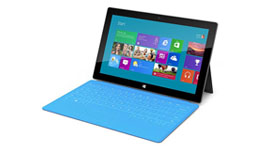
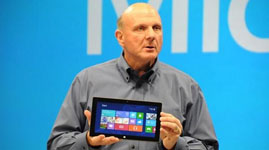
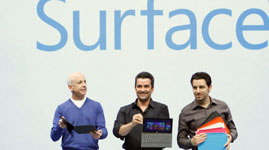
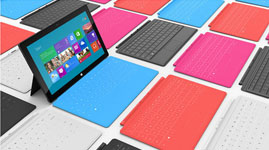
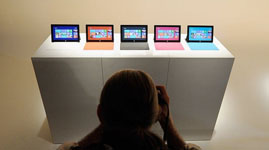

Early But Late
Microsoft's move to enter the tablet industry is considered late by many people since it has been two years after Apple's debut with iPad that Microsoft begins to try its bet on the tablet market. But although Apple and Google have been into the business long way before Microsoft, Microsoft is no stranger to tablets.
Back in 2001, Microsoft co-founder Bill Gates predicted tablets would be the most popular form of PCs sold in America within five years. At that time, a full decade before Apple unveiled iPad, Microsoft had already created its first tablet, Microsoft Tablet PC. But apparently, the tablet failed to get momentum. But when the tablet industry finally got traction, its because of Apple, not Microsoft.
Microsoft is known to be the titan in the software industry, powering most desktop computers with its Windows operating system. Since mobile device market started to grow, PC began to fall. Microsoft finally admits that the tech market is no longer software oriented where the company once pioneered. Microsoft finally enters the hardware industry with its own in-house built device powered by its own operating system to compete with the already popular iPads and Android powered tablets.
Microsoft's stock has languished for nearly a decade as Samsung, Google and Apple have stolen the mobile market in their earlier move. Microsoft has also struggled to make internet advances. The new tablet is Microsoft's strategy to get back into the competition. The device with its touch-friendly operating system is supposed to work equally well on more traditional personal computers and tablets.
Although Microsoft also has a successful history of making computer hardware such as mice and keyboards, as well as the popular Xbox video games console, it has previously relied on other manufacturers to produce PCs. Although nobody would comment on how those relationships will be affected, Ballmer said "We want to give Windows 8 its own companion hardware innovations."
And with Surface tablets, Microsoft for the first time is putting software and hardware under the same roof to control an outcome.
